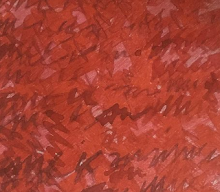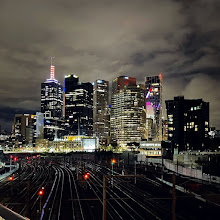The New Museum’s “Brion Gysin: Dream Machine” is intended as New York’s reintroduction to this painter, poet, innovator, and total subversive, and that it will be. Gysin was the artist’s artist among the Beats, the man who invented William S. Burroughs’s favorite writing technique—the cut-up, in which newspapers or other printed materials are sliced and reassembled to make unexpected new connections—and is a key figure in the development of postmodern literature, Kinetic art, street art, spoken-word poetry, and experimental punk, rock, and pop. Yet outside the art world, he’s been almost totally unknown, at least until now.
The building itself is a sturdy-looking brick chunk, built in 1884, that would blend into nearly any downtown block. In its early decades, it was home to the first modern YMCA. During and after World War II, the artists started to move in. First came the French Cubist Fernand Léger; painters James Brooks and Wynn Chamberlain arrived soon after. In 1958, Mark Rothko leased the building’s huge gymnasium to work on his murals for The Four Seasons, the ones whose story is told in the Broadway show Red. Rothko handed down his space to the second-generation Abstract Expressionist Michael Goldberg in 1962. Lynda Benglis, whose own retrospective opens at the New Museum in February, secured her loft in 1974; the sculptor and painter Lynn Umlauf, who later married Goldberg, came in 1977. (Both women still live and work there.)
The real social butterfly of 222, though, was Gysin’s former lover, the poet and artist John Giorno, who followed Chamberlain there in 1966. Giorno remembers one of Gysin’s long-ago visits vividly. It was 1978, and their affair had long since fizzled. Gysin was in town for the Nova Convention, a poetry festival co-produced by Giorno and dedicated to Gysin and Burroughs—who had moved into his own loft at 222, which he famously called “the Bunker.” Gysin was used to Parisian garrets, and loft life, with its high ceilings and few walls, was a revelation. He took one look at Giorno’s space, cluttered with Oriental rugs and piles of poems, and remarked, in his particular British-Canadian cadence, “You all live like bohemians!” Which they did.
What followed was typical of Giorno and Burroughs’s interlaced lifestyle. They escorted Gysin (and others, like Burroughs’s longtime companion James Grauerholz) down to the Bunker, where Burroughs drank (vodka) and Giorno cooked (bacon-wrapped chicken was a Burroughs favorite). Guests were always high and liquored up by the time dinner was served, at a conference table surrounded by orange vinyl chairs. Drinking and smoking would continue until 10 p.m. or so, when Burroughs would retreat to bed, after engaging his guests in some convivial target practice with his blowgun.
Things were always a little more intense when Gysin was in town. There were visits with Allen Ginsberg and Blondie. Keith Haring and Jean-Michel Basquiat were always around, stopping by with their expensive pot after dinner, getting Gysin high, and hanging on his every word. But it was Burroughs who was most affected by Gysin’s presence. The two had known each other for decades, going back to their time as expats in Tangier in the fifties, and “Brion brought out a very somber, self-conscious Burroughs,” says Stewart Meyer, a novelist and Bunker habitué. Giorno agrees: “When William was asked, ‘Did you ever love somebody?,’ he always said, ‘I’ve never respected anybody more than Brion Gysin in my life.’ That was his word for love. He had lovers, but somehow Brion was on another level. They were gay and never had sex together, but in a certain way Brion was William’s lover.” Meyer says Burroughs was painfully concerned with Gysin’s perception of him. “William could not paint while Brion was alive, though he had wanted to. He did not want to overshadow Brion in that area, because he had already overshadowed him in every other area.”
That continued up to Gysin’s death at 70, in 1986. He’d never become well known and never saw full publication of The Third Mind, the instructional tome (created with Burroughs) that meant to introduce the world to the cut-up. (Burroughs’s own cut-ups, the “Nova” trilogy, were not only published but are still in print.) “Brion knew it wasn’t William’s fault. But in terms of the general popular culture not recognizing the importance of his contribution, there was a little bitterness,” says the artist Genesis Breyer P-Orridge, who befriended Gysin in the late seventies and credits him with inspiring the project he undertook with his late wife, Lady Jaye. (The two literally cut themselves up via plastic surgery to form the “third being,” with matching lips, eyes, beauty marks, and breasts. Gysin’s methods taken to the extreme.)
The building at 222 retains vestiges of that era. Burroughs returned yearly until his death in 1997, and since then, Giorno has preserved the Bunker, adding a Buddhist meditation shrine opposite the kitchen. Burroughs’s typewriter is still here, as are the Gysin paintings he prized. Giorno accumulated three apartments in the building, and he and his partner, the artist Ugo Rondinone (whose HELL, YES! sculpture hangs on the New Museum’s façade), still hold eccentric, intimate dinners. But their world is vanishing fast. The top two floors have been bought and are rented out at market rate. Green Depot, an ecofriendly home-goods chain, occupies the storefront, and Goldberg’s (and thus Rothko’s) old space is changing hands at year’s end, its hardwood floor still caked with traces of both artists’ paint.
Rachel Wolff @'NY Mag'












